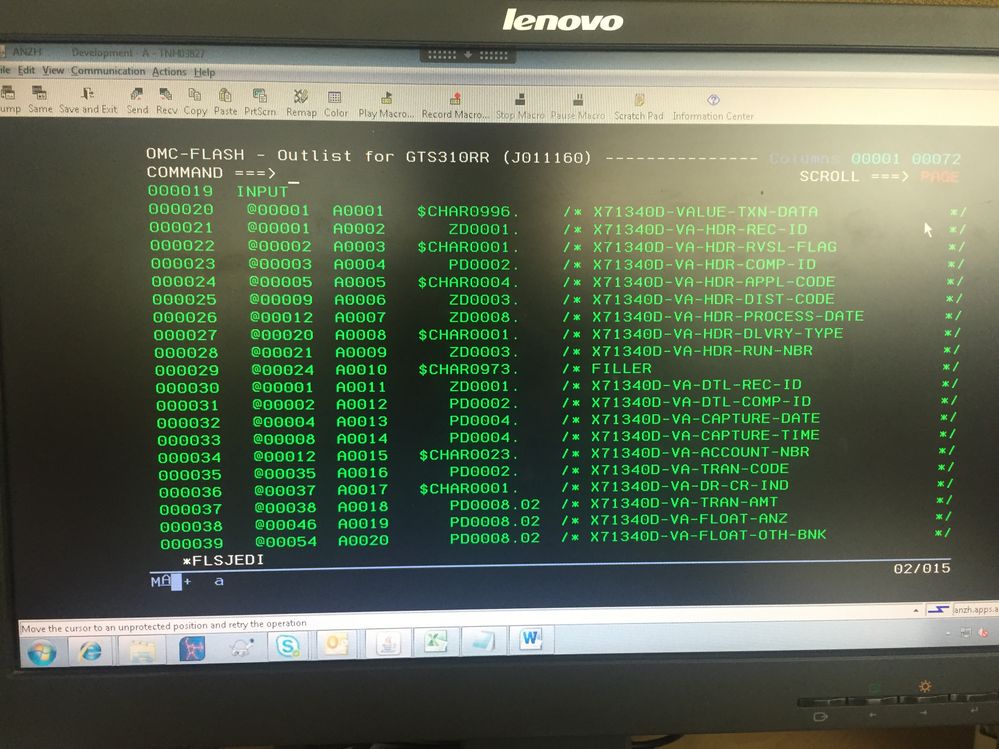- Home
- /
- Programming
- /
- Programming
- /
- Re: trying to read cobol raw dataset and converting into output datase...
- RSS Feed
- Mark Topic as New
- Mark Topic as Read
- Float this Topic for Current User
- Bookmark
- Subscribe
- Mute
- Printer Friendly Page
- Mark as New
- Bookmark
- Subscribe
- Mute
- RSS Feed
- Permalink
- Report Inappropriate Content
Hi Kurt,
Thanks for your reply.
Since this is dynamic flow, i will not be hard coding the label. It has to be read from the copy book and then take the field name as label name. Attached is the screen shot which i initially pasted.
now i want label names attached in the screen shot to be printed.
Regards,
Rakesh MS


- Mark as New
- Bookmark
- Subscribe
- Mute
- RSS Feed
- Permalink
- Report Inappropriate Content
Since we have already determined that the main attributes of the SAS variables cannot be reliably determined from the copybook, it does not make sense to just automate the labels. That's such a minor part of all the work that trying to automate it is just a waste of precious brain-cycles.
- Mark as New
- Bookmark
- Subscribe
- Mute
- RSS Feed
- Permalink
- Report Inappropriate Content
How to display labels in the put statement.
label A20219 "x50978 nvcb trans hand fee ";
data _null_;
set temp1;
file sasout dlm="," dsd;
put (_all_) (+0);
run;
- Mark as New
- Bookmark
- Subscribe
- Mute
- RSS Feed
- Permalink
- Report Inappropriate Content
You have to write the headerline in the datastep in the way I already showed you.
You can retrieve the labels automatically like this:
proc sql noprint;
select label into :headerline separated by ','
from dictionary.columns
where upcase(libname) = "LIBRARY" and upcase(memname) = "DATASET";
quit;The corresponding line of code in the datastep will then be:
if _n_ = 1 then put "&headerline";- Mark as New
- Bookmark
- Subscribe
- Mute
- RSS Feed
- Permalink
- Report Inappropriate Content
I am confused with the libarary name and dataset name. I have already have the label in my JCL(Just like below) control card. I want use them as label in the heading.
LABEL A0001 = "x50978D record ";
LABEL A0002 ="X50978D HD type ";
LABEL A0003 ="X50978D Account ";
Regards,
Rakesh MS
- Mark as New
- Bookmark
- Subscribe
- Mute
- RSS Feed
- Permalink
- Report Inappropriate Content
You use the library and dataset name of the dataset you create when you read the external file. The metadata of all datasets in all currently assigned libraries will dynamically appear in dictionary.columns.
Take the dataset & library name from the data statement of your current data step that reads the COBOL-originated file.
- Mark as New
- Bookmark
- Subscribe
- Mute
- RSS Feed
- Permalink
- Report Inappropriate Content
The file which is created doesn't have a header. Labels are with in the JCL only ( This is with in the job in control card)
I can print label to spool along with data conversion using below command but not able to write the same thing using ut statement
Proc print data = temp1 label noobs;
But i want tthe same thing to write it to the output file.
Regards,
Rakesh MS
- Mark as New
- Bookmark
- Subscribe
- Mute
- RSS Feed
- Permalink
- Report Inappropriate Content
To get the labels from dataset temp1 (no library given, so therefore that is a dataset in WORK), use
proc sql noprint;
select label into :headerline separated by ','
from dictionary.columns
where upcase(libname) = "WORK" and upcase(memname) = "TEMP1";
quit;Then use &headerline in the if _n_ =1 then put ..... statement.
- Mark as New
- Bookmark
- Subscribe
- Mute
- RSS Feed
- Permalink
- Report Inappropriate Content
- Mark as New
- Bookmark
- Subscribe
- Mute
- RSS Feed
- Permalink
- Report Inappropriate Content
I was referring to label like below
Proc print data label noobs;
I want the similar syntax while writing to the output file using put statement.
Regards,
Rakesh MS
- « Previous
-
- 1
- 2
- Next »
April 27 – 30 | Gaylord Texan | Grapevine, Texas
Registration is open
Walk in ready to learn. Walk out ready to deliver. This is the data and AI conference you can't afford to miss.
Register now and lock in 2025 pricing—just $495!
Learn how use the CAT functions in SAS to join values from multiple variables into a single value.
Find more tutorials on the SAS Users YouTube channel.
SAS Training: Just a Click Away
Ready to level-up your skills? Choose your own adventure.


